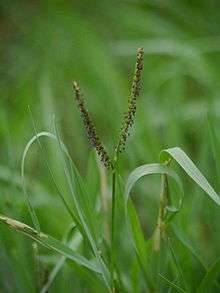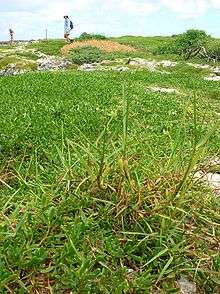Paspalum
Paspalum is a genus of plants in the grass family.[3][4]
| Paspalum | |
|---|---|
 | |
| Paspalum distichum | |
| Scientific classification | |
| Kingdom: | Plantae |
| Clade: | Tracheophytes |
| Clade: | Angiosperms |
| Clade: | Monocots |
| Clade: | Commelinids |
| Order: | Poales |
| Family: | Poaceae |
| Subfamily: | Panicoideae |
| Supertribe: | Andropogonodae |
| Tribe: | Paspaleae |
| Subtribe: | Paspalinae |
| Genus: | Paspalum L. |
| Type species | |
| Paspalum dimidiatum | |
| Synonyms[2] | |
| |

The group is widespread across much of Asia, Africa, Australia, and the Americas. Commonly known as paspalum, bahiagrasses, crowngrasses or dallis grasses, many of the species are tall perennial New World grasses. They are warm-season C4 grasses and are most diverse in subtropical and tropical regions.[5][6][7][8][9][10][11][12]
Paspalum scrobiculatum (koda, varuka, varuku, etc.) is a millet locally grown as food grain. Some species, such as bahiagrass (P. notatum) and P. nicorae, are grown for pasturage, especially with the perennial forage peanut (Arachis glabrata) as a companion crop. Bahiagrass has also some significance as a honey plant.
Water finger-grass (P. vaginatum) resembles bermudagrass (Cynodon dactylon), but has a higher salinity tolerance and can consume greywater. It is not infrequently used for arena and golf course turf in warmer coastal regions, such as Baja California, Florida, Peru, Texas and Venezuela. Dedicated paspalum cultivars such as 'Aloha Seashore' or 'Platinum TE' have been produced for such uses.
Paspalums are also food for caterpillars of lepidopterans such as the pasture day moth (Apina callisto), and those of the dark palm dart (Telicota ancilla) which feed on P. urvillei. Granivorous birds often eat paspalum seeds; the chestnut-breasted munia (Lonchura castaneothorax) readily feeds on the seeds of P. longifolium, for example.
The ergot Claviceps paspali is a sac fungus that grows on Paspalum, producing ergot alkaloids and the tremorgen paspalitrem; it causes "paspalum staggers" poisoning in cattle.
Tussock paspalum (P. quadrifarium) is considered a weed in Australia.[13]
Selected species
|
|
Formerly placed here
- Axonopus compressus (broad-leaved carpetgrass), as P. compressum, P. platycaule, P. platycaulon
- Axonopus fissifolius (narrow-leaved carpetgrass), as P. fissifolium
- Digitaria exilis (fonio), as P. exile
References
- Chase, Agnes. 1911. Notes on genera of Paniceae. IV. Proceedings of the Biological Society of Washington 24: 137 lectotype designation
- Kew World Checklist of Selected Plant Families
- Linnaeus, Carl von. 1759. Systema Naturae, Editio Decima (10th edition) 2: 846, 855, 1359
- Tropicos, Paspalum L.
- Flora of China Vol. 22 Page 526 雀稗属 que bai shu Paspalum Linnaeus
- Flora of Pakistan
- Altervista Flora Italiana, genere Paspalum photos and distribution maps of several species
- Biota of North America 2013 county distribution maps
- Atlas of Living Australia
- Denham, S. S. 2005. Revisión sistemática del subgénero Harpostachys de Paspalum (Poaceae: Panicoideae: Paniceae). Annals of the Missouri Botanical Garden 92(4): 463–532
- Ferreira, C. G., R. C. Oliveira, J. F. M. Valls & M. I. Bezerra de Loiola. 2009. Poaceae da Estação Ecológica do Seridó, Rio Grande do Norte, Brasil. Hoehnea 36(4): 679–707
- Zuloaga, F. O., J. Pensiero & O. Morrone. 2004. Systematics of Paspalum group Notata (Poaceae-Panicoideae-Paniceae). Systematic Botany Monographs 71: 1–75
- AWC (2008)
- Australian Weeds Committee (AWC) (2008): Noxious Weed List for Australian States and Territories. Version 18.00, September 2008. PDF fulltext
| Wikimedia Commons has media related to Paspalum. |